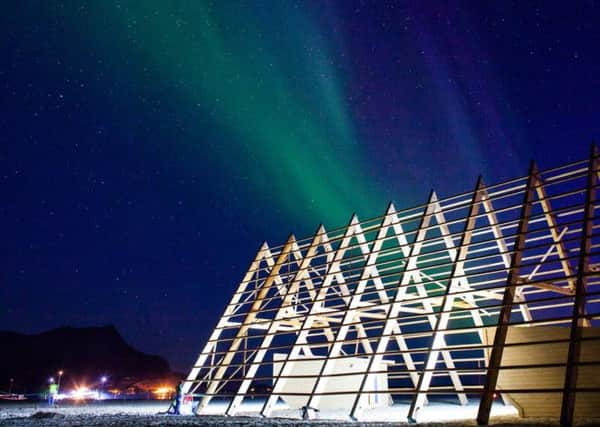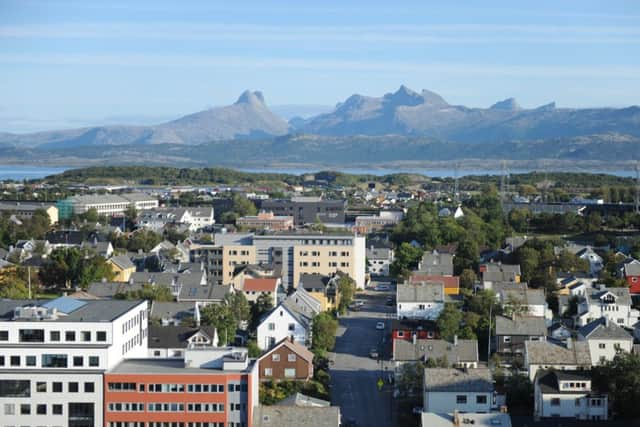Travel: The wonder of the Article Circle in Norway


SALT is an ambitious and inspirational concept designed to stir the imagination using the nature and history of the Arctic Circle as a framework for strong artistic and cultural experiences. The SALT journey started on the remote Norwegian beach of Langsand on the 103 km sq mountainous island of Sandhornøya in the municipality of Gildeskål, which is located just south of the town of Bodø in the Arctic Circle.
The nomadic project was inspired by the environment of the Arctic Circle and will bring together art, music and architecture created to reflect the region. It will stay in Norway until 6 September before relocating to Greenland, Iceland, Scotland, the Faroe Islands, Ireland, Spitsbergen, Alaska and Russia over the next five years.
Advertisement
Hide AdAdvertisement
Hide AdIt is epic in proportion, and each international location will feature world-renowned artists who have been invited to create work connected to the spectacular, yet endangered, landscape of the Arctic.


To visit SALT’s Norwegian location, 80km south of Bodø (pronounced Bodah), I board a small ferryboat which departs from the dock outside Bodø’s Radisson Blue Hotel. After travelling 40 minutes across smooth water with views of massive, distant glaciers and snow-covered peaks, I disembark and walk along a rickety jetty and on to the remote Langsand beach. The island of Sandhornøya can also be reached from the mainland via the Sandhornøy Bridge with an easy drive along Route 17 through pretty coastal villages.
On the remote beach stand three wooden structures dubbed “Arctic pyramids” – although they are actually triangular prisms – which resemble the fiskehjelle, giant racks used by the region’s fishermen to dry their catch. They function as a framework for SALT’s cultural programmes and were developed by Finnish architect Sami Rintala. During the day the sun casts shadows over the giant fish racks creating a criss-cross pattern on the sand.
It’s August, and at 7pm the sun is still casting light across this Arctic region. It’s not until 9pm that it very slowly fades, but not completely. A strong deep-red strip sits on the horizon for hours; it is the slowest sunset I’ve ever seen.
Helga-Marie Nordby and Erland Mogard-Larsen first conceived the idea of SALT in 2010, while curating the Lofoten International Art Festival.
“We travelled around northern Norway for two years trying to find the right location. Some islands were too remote, but this island is ideal and easy to reach by road or boat,” says Nordby.
“The Arctic is largely unpopulated, hardly anyone lives here and no-one really knows what is going on. Environmental organisations say their struggle is to get people engaged and interested in asking questions about the environment and what is happening,” she adds.
One oversized 130m-long fish rack serves as SALT’s art and music platform and is showing a film created by one of China’s best-known contemporary artists and filmmakers, Yang Fudong.Fudong’s site-specific outdoor film, The Light That I Feel, was commissioned as part of the opening installation of SALT. It is a slow-moving black and white film (edited into eight shorts shown inside small pine huts) and depicts local Norwegian dancers and actors on the beach.
Advertisement
Hide AdAdvertisement
Hide AdThis summer an environmental project called State Of The Arctic will replace the current installation. Focusing on climate change and resource exploitation in the region, it will use art as a starting point, rather than science, with researchers coming to talk about the issues and performances, readings and theatre raising questions in a unique way.
There’s softness to the cloudless evening sky, as the slow sunset casts a reddish tint across the glass-like water. When the light slowly fades, the temperature drops and people start to add layers to keep warm. A huge bonfire burns on the beach. People gather, drawn by the roaring flames that throw glowworm embers into the sky.
As well-known Norwegian Goth band, Slagr, with their pagan drummers and chants, perform 18th-century Nordic songs which draw people to the main stage, back at Yang’s installation, the darkness brings out the light of his film. People drift through the fish rack structure in the darkness, stopping to watch the film; it’s like a walk-through cinema.
Further down the beach, people gather in the giant sauna, another triangular prism, in a style similar to the fish rack stage and the installation. Made from local pinewood, it’s the largest. When close to poached, the sauna worshippers run outside and plunge their steaming bodies into the cold seawater, with cries of shock and then laughter which echo off the nearby cliffs. The sauna costs £19, including a towel, and is open all year round.
And so to bed. Among a few skinny trees and low bushes, I discover a small wood and canvas structure raised above the sand on stilts and known locally known as a njalla. I climb into the cabin; it has a bed on either side of a short and narrow divide, along with a powerful heater so there’s no chance of being cold during the night. Bedding is provided, as are lanterns. And thankfully the path all the way to the toilet and shower facilities is also lit. Through the glass strip in the roof, as I lie on my twig and reindeer-skin mattress, I am mesmerised by the Northern Lights dancing overhead.
The following morning I travel north on a small Arctic RIB boat (www.arcticrib.no), hugging the coast until we reach the old trading post and village at Kjerringoy, a traditionally restored village community that you can also reach by a 60-minute car journey. The village offers an insight into what life was like a few hundred years ago.
At nearby Markens Grøde, an organic café owned by farmer Astrid Olsen, there are elk and moose burgers on the menu. Each regional farm may hunt up to 15 elk or moose a season for personal use, and Olsen serves his quota at his restaurant, along with homemade organic cheeses and beer.
Back on the boat, we return south towards Bodø and then enter the Saltstraumen Strait, just 10km southeast of Bodø. The strait is infamous for having the strongest maelstrom in the world, a natural occurrence that is a mass of swirling and fast travelling tidal water. The ride across the maelstrom is impressive and thrilling as the unpredictable currents randomly turn small swirls into black holes big enough to swallow our boat. It’s unnerving at times, especially when the boat is sucked towards the whirling pools by this massive force of nature.
Advertisement
Hide AdAdvertisement
Hide AdWe leave for calmer waters, following inlets dotted with small houses and magnificent rock formations, speeding along pristine waterways while eagles fly overhead.
I end the day kayaking with Sigurd Schultz, who owns a local kayaking business. We paddle across the shipping lane, riding the waves from passing boats, before reaching islands popular with nesting birds and remote Arctic beaches – a spectacular way to end the day.
• SALT’s ongoing programme of events will take place across the year. Ticket prices range from £15 to £75 (www.salted.no)
FACT FILE:
• SALT is on Sandhornøya until 6 September. Special Njalla heated cabins sleep up to four and cost £125 a night for one person, plus £20 for each extra person.
• Event tickets start from £15. A day package with transfers from the town of Bodø, guided tour, dinner and sauna costs £126pp. Book at www.salted.no.
• Norwegian Airlines (norwegian.com) flies to Oslo from Gatwick and Manchester from £70 return, and from Oslo to Bodø from £145 return. Single from Bodø to Sandhornøya costs £19.50 ferry, £13 bus.
• SALT: www.salted.no
• Bobø Tourist Office: www.visitbodo.com
• Visit Norway: www.visitnorway.com
• Avis car rental: www.avis.no
• RIB Boats: www.arcticrib.no
• Kayaking: Sigurd Schultz offers English kayaking tours of the local Bodø region. With guided trips from £82. www.rettkjol.no